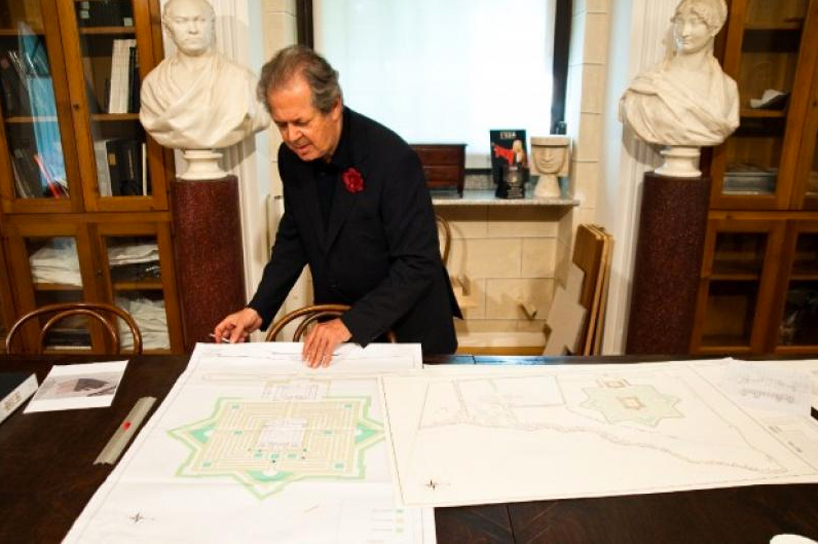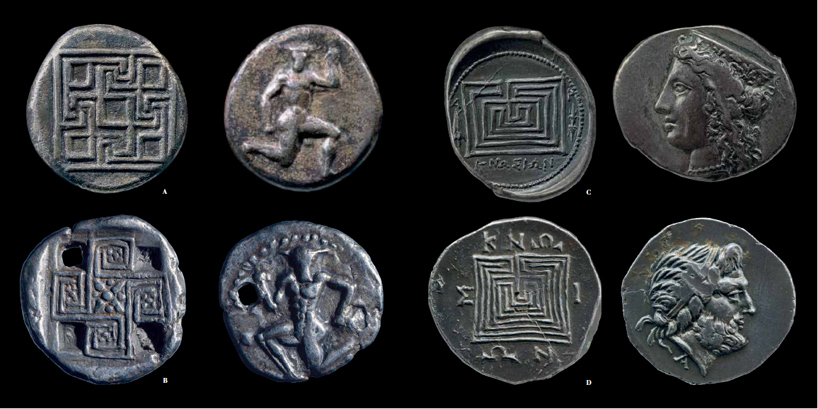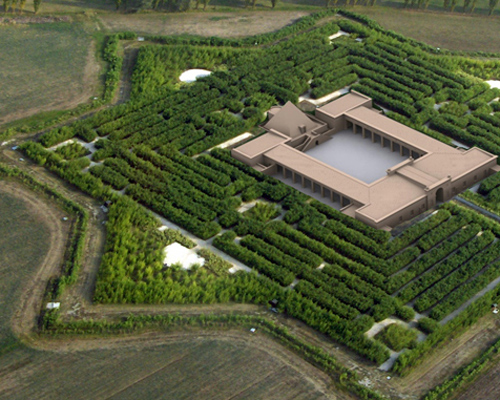‘labyrinths: the art of the maze‘
publisher: rizzoli USA
author: franco maria ricci
ISBN: 978-0-8478-4164-6
features: hardcover, 223 pages
year: november 2013
text: by giovanni mariotti and luisa biondetti, edited by franco mari ricci
language: english
in this book franco maria ricci explores labyrinths in every form – drawn graffiti-like on crockery, stamped on coins, traced in manuscript illuminations, carved on cathedral walls, and planted in gardens – and features literary quotations from herodotus and pliny to jorge luis borges.
the straight line infallibly chooses the shorter way between two points. this is its line of behavior; it could not act in any other way. as for men, seldom are they capable of imitating this simple and virtuous example, a model of rectitude. the way the land is shaped, a plateau, an impenetrable forest, a waterway that cannot be crossed, mud, the roaring of a beast, an enemy in ambush, a landslide, a one-way street: all force us to take winding roads and detours. not even the flat surface of the seas guarantees those who sail it the chance to follow a straight line. winds, storms, dead calm, and rocks could transform even the most resolute of routes into a series of freakish meanders. very rarely does the shortest way lead directly to the goal: we need to patiently undergo the complications of the world, of which labyrinths are a reflection. and every time we stray from the right path, change direction to avoid an obstacle, venture into unknown territories, we run the risk of getting lost. aside from some discomfort, one of the first consequences of getting lost is the belief that the destination, as long as we have one, cannot be reached and corridor after corridor, cistern after cistern, the lack of any direction does not allow one to tell a place from another: everything is repetition in the labyrinth.
the etymology of the word labyrinth is uncertain. the greek word ‘dapurito’ had four syllables, and no one knows for sure whether it evolved into the word ‘labyrinth’.
certain seashells, known as ‘labúrinthoi’ in greek had their influence on its name.
in the beginning, the labyrinth must have seemed unwelcoming, spiteful, hostile, to the point that it became, in the minds of men, the place where the monster (the minotaurus) lived. over time, art, dance, literature, in every sort of fiction, in reassuring contexts, along with the scarcity of the species ‘minotaurus minotaurus’ would make the word lighter and sweeter, which by that time was also used for pleasant things, like certain garden ornaments. but even today the threshold of a labyrinth cannot be crossed without a slight tremor: no frisson, no labyrinth.
the labyrinth, and pre- or protoor para-labyrinthine forms, such as the spiral, were crossed from the beginning by a fluid multiplicity of meanings, and if the labyrinth is a model of the world, it is nonetheless of interest that there are three basic models.
(A) one of these is the classical labyrinth of knossos, which has a single path and is known as unicursal. it represents a safe and reassuring structure: because once you enter all you can do is reach the center, and from the center all you can do is retrace your steps. for over two thousand five hundred years, from the time of ancient greece to the age of mannerism, there were neither bifurcations nor blind alleys; there was a single pathway that led to the center, although at certain moments in the journey the destination appeared to be farther away than it had at the start: so that anyone walking the labyrinth had the impression of advancing by moving backward, or of moving backward by advancing. it was an oscillatory effect, one that added to the pathway an attractive metaphysical touch. yet the risk of getting lost was missing. the unicursal labyrinth was safe, but not tranquilizing. this was because it belonged to the family of movements away from the straight line, the deviations – in other words, the tortuous, and the tortuous has always caused a sense of unease, a certain malaise.
the graphic invention that characterizes the roman pavement labyrinths is the division into four sectors, almost four independent labyrinths, designed so as to force people to undertake a long, inescapable walk, to cross one labyrinth entirely before reaching the next. the physiognomy of roman labyrinths is born from the adaptation of the tortuous to the rectilinear (with rare exceptions, dominating those intrigues were the square and the ninety-degree angle), from the victory of the broken line over the curve: phenomena that take place within a style, an aesthetic.
coins from knossos, 450-100 BC
during the long and turbulent centuries descendants would later call the middle ages, labyrinths migrated from villas and ruined baths and found asylum in churches. churches adopted the unicursal labyrinths, using them as symbols and disseminating them in cathedrals: most church’s task was to help the faithful to undertake that difficult path, but without alternatives, at least for anyone aspiring to eternal salvation. in the twentieth century, the original and univocal meaning of the labyrinth would have been searched for, the authentic meaning because it was linked to the sacred, to archaic cults. among all the hypotheses, there was one that would end up being the most authoritative of all: the labyrinth was born as the representation of the diaphragm that lies between the world of the living and the world of the dead, obstructing their interaction in a generally efficient way, and as sacred scenography, for the initiatory and symbolic walks of death and rebirth.
episodes from cretan mythology, 1510-1520
(B) the baroque labyrinth is of the second type, the ‘irrweg’ – the multicursal labyrinth. it suggests alternative choices, but all the paths lead to a dead end, except for one. mistakes can be made, and one is often forced to retrace one’s steps and try another path. those who instead entered a multicursal labyrinth committed or avoided the mistakes that others had not committed or not avoided. the path he took was his and his alone. everything had changed. each bifurcation meant hesitating; each interrupted path meant rethinking… on what is the development of a tragedy such as ‘hamlet’ based if not on a whole series of hesitations, and thus procrastinations, ponderings… and is not the most famous of all monologues ‘to be or not to be‘, formulated like a dilemma, and thus a bifurcation? the bifurcation is not just a place for perplexity and delays: it is also a place where choices are made. the individual can bet on one direction or another; however, we must not overlook the fact that, from a mythical viewpoint, the labyrinth is a prison. the bifurcations make it more complicated, and at the same time they bestow the person moving about this prison, unable to find a way out, the illusion of freedom.

(C + D) the third type of labyrinth is a network, in which every single point can be connected to every other point. a network cannot be rolled out. also because, while the labyrinths belonging to the first two types have an inside (their own intrigue) and an outside, from which one enters and towards which one leaves, the third type of labyrinth, which can be extended ad infinitum, has neither an inside nor an outside – seeing that the network is endless in size or, for those who live inside it, coextensive to the whole universe, and outside it there is just nothing. as every one of its points can be connected to every other point, and the process of connection is also a continuous process of the correction of the connections, its structure would always differ from what it was an instant before, and each and every time it could be walked along different lines. so the person who travels there must also learn to continually adjust their image of it, whether it is a concrete image of one of its sections or the regulating and hypothetical image that concerns its overall structure. the labyrinth that can fascinate us the most today is this one that promises us a network. whose path can always provide us with new ways; and in any case, we have the impression that we can never exit from this infinite research.
‘labyrinths: the art of the maze‘, is prefaced with a foreword by philosopher and semantics expert umberto echo: ‘if the image of the labyrinth has a centuries-old history, this means that for tens of thousands of years human beings have been fascinated by something that somehow spoke to them of the human or cosmic condition. there are endless situations in which it is easy to enter, but hard to exit, and at the first attempt, it seems hard to think of situations where it is difficult to enter but easy to exit.’
all images of this book report courtesy of rizzoli USA.





contemplation by design (12)
designboom book reports (197)
franco maria ricci (8)
labyrinth (4)
PRODUCT LIBRARY
a diverse digital database that acts as a valuable guide in gaining insight and information about a product directly from the manufacturer, and serves as a rich reference point in developing a project or scheme.
























